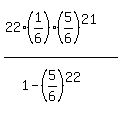.
Let us solve the problem step by step.
1. The probability that a six is rolled exactly once, if it is known that at least one six is rolled, is equal to the ratio,
where the numerator is the probability that a six is rolled exactly once,
while the denominator is the probability that at least one six is rolled.
2. The numerator is equal to  =
=  .
3. The denominator is the complement to the probability that no one six is rolled.
The probability that no one six is rolled is
.
3. The denominator is the complement to the probability that no one six is rolled.
The probability that no one six is rolled is  ; hence, the complement to it is 1 -
; hence, the complement to it is 1 -  .
4. Therefore, the probability under the question is
.
4. Therefore, the probability under the question is
 = 0.081172 = 8.1172% (approximately). ANSWER
= 0.081172 = 8.1172% (approximately). ANSWER
Solved.